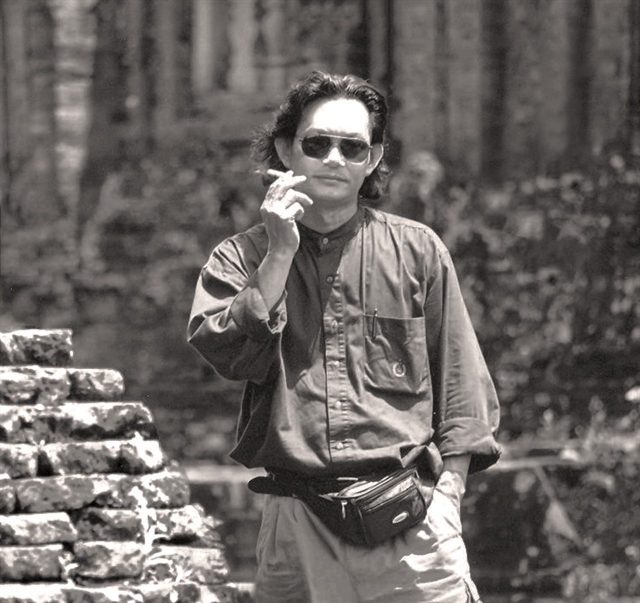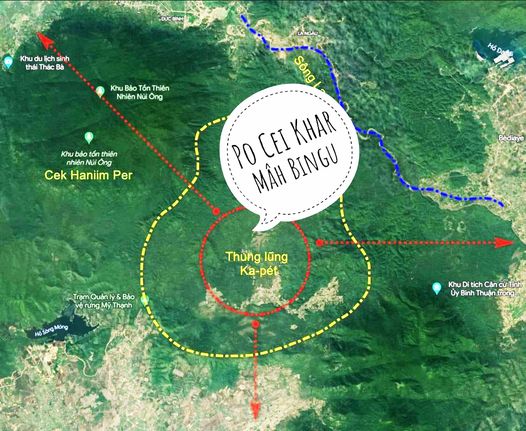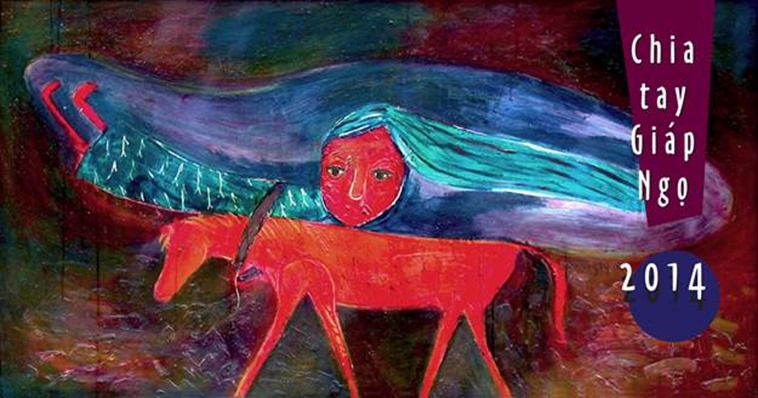Vĩnh Quyền
Không trách các báo im lặng khi tôi gửi tản văn về Kapet nhưng sẽ không tha thứ bản thân nếu im lặng. Đây là bản thảo 6 tháng trước, không buồn cập nhật thời sự, bởi Kapet vẫn sẽ là “ký ức tương lai” từ giữa 2024.
Vĩnh Quyền
Trong đời viết, tôi dành khá nhiều chuyến dã ngoại đến những ngôi làng và thánh tích Cham. Chừng đó, và cả cuốn L’art du Champà et son évolution của Philippe Stern cổ kính phục sẵn trong tủ sách gia đình ở Huế trước khi tôi chào đời, không đủ giúp tôi hiểu sâu văn hóa đậm đặc, ẩn khuất của người anh em này. Nhưng tôi tin mình dần nhận biết điều cốt tủy. Ấy là Cham không từ bỏ đất thiêng, nơi họ đã dựng đền đài thờ phụng thần linh và thánh nhân của họ.
Mấy thế kỷ gần đây thiên tai và chiến tranh tàn phá không ngớt thánh địa Cham. Nhưng Cham không quên lãng. Không gian thiêng dẫu lụi tàn trên sỏi đá vẫn sống động trong tâm thức Cham với sự hỗ trợ tuyệt vời từ chuyện kể và thương ca. Nương đôi cánh của lời, cảm thức lịch sử chuyển lưu, hồi quang thứ ánh sáng đã tắt tự bao giờ trong mắt thế nhân. Để khi hội đủ phước duyên Cham lặng lẽ rủ nhau về đất cũ trùng tu phế tích và tiếp tục hành hương.
Rồi những ngày này, nhà đầu tư-tỉnh Bình Thuận và Quốc hội tái kích hoạt một kế hoạch ngủ đông từ 2019 bởi Covid-19, ra quyết định biến diện tích 619ha rừng Kapet ở huyện Hàm Thuận Nam, gồm 137.95ha rừng đặc dụng, thành hồ chứa nước chống hạn. Một quyết định thực tiễn, có mục đích cải thiện tình hình sản xuất nông nghiệp hiện nay của địa phương. Đáng tiếc, nhà đầu tư đã xem nhẹ phần việc quan trọng là đánh giá tác động dự án đối với môi trường văn hóa bản địa. Tôi đang nói đến một Kapet-không-gian-sống bao đời của các cộng đồng thiểu số Cham, Raglai, Cru và K’ho. Và tôi đang nói đến một Kapet-không-gian-thiêng đánh dấu bằng thánh tích, bằng lễ hội hành hương. Tất cả sẽ bị nhấn chìm vĩnh viễn dưới đáy hồ nhân tạo bằng các quyết định nói trên. Vậy mà trong “15 ngày lắng nghe phản biện” dự án, đồng bào Cham, Raglai dường như không có tiếng nói thật sự.
Trước và sau cuộc họp báo (7.9.2023) về dự án Kapet của tỉnh Bình Thuận, dư luận xã hội vẫn không ngừng tranh cãi. Có ý kiến hoan nghênh dự án bởi chống hạn luôn là nhu cầu ở một vùng nông nghiệp thiếu nước như Bình Thuận, “dân trên hết”. Có ý kiến phản đối vì tầm nhìn dự án chưa thuyết phục, nên cân nhắc thêm, bởi nước và rừng đều là tài nguyên quan trọng, không thể hủy hoại rừng đổi nước, cần xét khả năng thay thế, chẳng hạn đầu tư vào hồ tự nhiên Biển Lạc “bỏ hoang nhiều năm” để không phải “nhấn chìm” rừng.
Trong một diễn biến khác, khi nhà đầu tư cố thuyết phục giá trị của rừng Kapet không tới mức phải băn khoăn khi “khai thác” thì những nhà khoa học lâm sinh nghĩ khác. Họ đưa ra kết quả khảo sát mới nhất: phát hiện tại rừng Kapet thêm 2 loài cây quý hiếm và 57 loài động vật nằm trong danh mục Sách đỏ Việt Nam, Công ước CITES và Nghị định 32 của Chính phủ.
Tôi thuộc nhóm ý kiến thứ hai, cộng thêm nội dung đã đề cập từ đầu câu chuyện. Rằng rừng Kapet không chỉ là sinh cảnh tự nhiên của chim muông mà còn là mái nhà xanh lâu đời của các dân tộc anh em, nơi tồn tại đền thờ hai vị khai khẩn vùng Bình Thuận là Po Haniim Pôr và Po Cei Khar Mâh Bingu. Hơn 300 năm qua, định kỳ bảy năm một lần, đồng bào Cham, Raglai ở Bình Thuận và từ các nơi hành hương đến đây thực hành lễ tắm xương cốt vị thánh của họ, Po Cei Khar Mâh Bingu, nhân vật các vua triều Nguyễn hai lần ban sắc phong.
Sau bom đạn chiến tranh là tiếp ngay những cơn bão khai thác gỗ kéo dài như vô tận. Vào Google Maps, gõ “ngã ba Đông Dương”, vệ tinh cung cấp hình ảnh lở loét đau lòng của rừng Việt khi nó nằm cạnh rừng nguyên sinh bạt ngàn xanh thẳm thuộc hai nước láng giềng. Trong tình cảnh chung như vậy, rừng Kapet đến nay vẫn giữ được căn cốt nguyên sinh. Đó là kết quả cộng sinh giữa thế giới tự nhiên với tinh thần văn hóa bản địa. Cham, Raglai hàng thế kỷ qua đã không nhìn Kapet như nguồn lợi để “khai thác” mà là đất thánh, là không gian thiêng muôn đời muôn kiếp.
Theo cuộc họp báo, dự án hồ chứa nước Kapet sẽ khởi công vào quý 2-2024 và hoàn thành vào cuối 2025. Lúc ấy, 7.762ha đất nông nghiệp khát nước của Hàm Thuận Nam sẽ được tưới mát, mang lại niềm vui mùa vụ tốt tươi cho người nông dân địa phương. Những cánh rừng trồng mát dịu trong nắng gắt sẽ mọc lên theo cam kết “giảm thiểu tác động tiêu cực”, dẫu nhiều nhà lâm sinh không tin chúng có thể hoàn toàn thay thế giá trị cánh rừng xưa. Thiệt hại này sẽ không được ai quan tâm đo đếm chính xác để rút ra bài học, như lâu nay vẫn vậy.
Đồng thời, người Cham sẽ lặng lẽ di dời đền thánh Po Cei Khar Mâh Bingu đến vị trí mới nào đó, tiếp tục lặng lẽ thờ phụng. Nhưng như tôi biết, Kapet sẽ không đi vào quên lãng. Rừng thiêng ấy mãi neo lại trong ký ức, trong chuyện kể truyền đời và trong thương ca Cham.
Dẫu không hy vọng nhà đầu tư và Quốc hội sẽ thay đổi quyết định đã dành cho số phận rừng Kapet, nhưng tôi vẫn không thể không một lần nói lên giá trị tinh thần văn hóa bản địa trong cuộc trường tồn của đất nước chúng ta.
Cũng là việc ngày thường của một nhà văn.
Kapet Reservoir Project needs to pay attention to preserving the native culture
By Vĩnh Quyền*
ince 2019, investors and state managers have been evaluating the possibility of clearing almost 619 hectares of Kapet Forest in Bình Thuận Province, including 137.95 hectares of special-use forest, to construct a new irrigation lake.

Writer Vĩnh Quyền at a Cham sanctuary. Photo Vũ Mạnh Cường
Throughout my writing career, I have conducted numerous field trips to Cham villages and sanctuaries in Việt Nam. Although I have not fully grasped the intricacies of their culture, I have observed a crucial aspect: the Cham people’s unwavering attachment to their sacred land, where they constructed structures to honour their gods and saints. Despite the destruction of many Cham relics due to natural disasters and wars, the Cham people have not forgotten them. They remain vivid in their minds, and legends and poetry preserve the light of the fading sun alive across generations in families and communities. Then, when conditions permitted, they returned to these painful ruins and restored them.
Since 2019, investors and state managers have been evaluating the possibility of clearing almost 619 hectares of Kapet Forest in Bình Thuận Province, including 137.95 hectares of special-use forest, to construct a new irrigation lake. However, they have failed to address the potential harm to the local cultural environment. Specifically, I would like to bring attention to the Raglai ethnic community, whose livelihoods are intertwined with the Kapet Forest. The area also contains Cham relics that have been present for over 300 years, which will soon be submerged by the artificial lake.
According to information from the press conference on September 7, 2023 by Bình Thuận Province, the National Assembly approved the Kapet Reservoir project in 2019, which has a capacity exceeding 51 million cubic meters and a total investment of VNĐ874 billion (approximately US$36.4 million). The project’s primary goals are to supply water for agricultural purposes in South Hàm Thuận District, support production activities in the Hàm Kiệm 2 Industrial Zone, and meet the daily water needs of South Hàm Thuận District and Phan Thiết City. Additionally, the project will serve flood prevention and control, environmental enhancement, and water regulation for downstream areas of South Hàm Thuận District and Bình Thuận Province. The reservoir will increase water availability during the dry season, benefiting Phan Thiết City and contributing to the development of tourism and service sectors in the province.

Po Cei Khar Mâh Bingu Temple in the Kapet Forest.
However, the project plans to clear 619 hectares of natural forest in Mỹ Thạnh Commune, South Hàm Thuận District. According to the Law on Forestry, Bình Thuận Province must replant around 1,844 hectares of forest in different locations to compensate for the lost forest area. The law stipulates that the replacement forest must be three times the size of the natural forest that has been converted for other purposes, with an estimated total cost of planting replacement forests at approximately VNĐ177 billion ($7.3 million). The project underwent a survey, inventory and assessment of the forest’s status.
On June 28, 2023, the Ministry of Natural Resources and Environment (MONRE) granted a licence to the project for exploitation, while local authorities submitted the environmental impact assessment to MONRE in August this year.
The purpose of constructing a new irrigation lake, the 50th in Bình Thuận Province, is clear: to alleviate the shortage of water for daily life, agricultural production and other industries.
However, there are two opposing views regarding the project before and after the press conference. On one side, supporters argue that it is necessary to improve the livelihoods. On the other side, opponents say that the project’s cost of losing forests for water is too high, as both resources are vital for human life, and there are viable alternatives to have water without losing forests. They criticised South Hàm Thuận District for having a water reservoir that has been abandoned for many years. Some scientists support this view. While investors and licencing agencies try to convince that Kapet is mostly a poor forest, they have just discovered in Kapet Forest two rare tree species and 57 animal species listed in the Việt Nam Red Book (2007), CITES, Decree 32 of the Government.
I belong to the second group mentioned above, but my reason for being here has already been explained. The Kapet Valley is not only a natural habitat for various animals, but it is also a long-standing home for several different native groups, including the Cru, Raglai, K’ho, and Cham people. This valley acts as a protective green roof that preserves the ancient culture of Cham, spanning more than 10 hectares. I find the temples dedicated to the two founders, Po Haniim Pôr and Po Cei Khar Mâh Bingu, fascinating to discuss. Po Cei Khar Mâh Bingu was even bestowed with a prestigious title twice by the kings of the Nguyễn Dynasty.
Over 300 years, and for every seven years, the Cham-Raglai Bình Thuận community has organised a pilgrimage to the Kapet relics and performed a bone bathing ceremony for their saint, Po Cei Khar Mâh Bingu. The Cham and Raglai people have safeguarded this forest as their sacred space, allowing it to retain its characteristics as a primitive forest, which serves as evidence of the birth of Bình Thuận Province over 300 years ago.
But now, the Cham-Raglai people have not had their say during the 15-day public opinion period that recently ended, concerning the environmental impact of the decision to destroy Kapet Forest for a water reservoir.
If nothing changes before the construction start order is issued, everything will be submerged beneath the lake, lost forever.
Life will go on, but it will not be the same.
The water source will benefit 7,762 hectares of agricultural land in South Hàm Thuận District, providing happiness to local farmers. New afforests will be planted according to the commitment, even though everyone knows in advance that they can never replace the primary forests that were exploited, resulting in an immeasurable loss.
Similarly, the Cham-Raglai people will move their Po Cei Khar Mâh Bingu temple to a new location to continue worshiping, but the ancient holy land will not be forgotten. It will live on in new Cham stories and laments.
More broadly, everyone who is interested in the country’s history will not forget our behavior towards nature today. We have decided to submerge historical sites into an artificial lake bed. That loss cannot be compensated for and cannot be forgotten.
____
* Vĩnh Quyền, a member of the Vietnam Writers Association and former Head of the Lao Dong Newspaper Representative Office in Central and Central Highlands, Vietnam, has authored 20 books in Vietnamese and three novels in English: Debris of Debris, Inside Infinity, and Heart for Forests.
The Vietnam Writers Association awarded him two novel awards: Debris of Debris (2016) and Inside Infinity (2019). Recently, in August of this year, his novel Inside Infinity was recognized with the Southeast Asian Writers Award.




